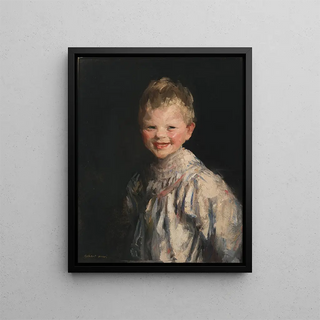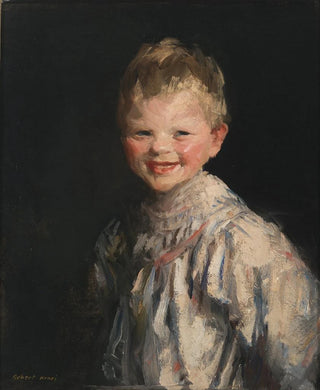Art print | Child Laughing - Robert Henri


View from behind

Frame (optional)
In the fascinating world of art, some artworks manage to capture the very essence of humanity with such intensity that they transcend time and space. "Laughter Child" by Robert Henri is one of these creations. Painted in the early 20th century, this iconic piece evokes joy, innocence, and the liveliness of a child, while offering a profound reflection on human nature. Through its radiant smile, Henri invites us to rediscover the wonder and curiosity that characterize childhood. The beauty of this work lies not only in its subject but also in the way it manages to communicate a universal emotion, touching the hearts of those who contemplate it.
Style and uniqueness of the work
Robert Henri's style is marked by a bold and expressive approach that stands out in the American Impressionist movement. "Laughter Child" perfectly illustrates his penchant for light and color, as well as his ability to capture fleeting moments of everyday life. The vibrant palette of warm and luminous colors, combined with energetic brushstrokes, creates a lively and dynamic atmosphere. Henri does not merely reproduce the face of a child; he manages to convey a palpable emotion, a contagious joy that emerges from the canvas. This piece is a celebration of life, where every detail, from the smile to the sparkling eyes, is carefully orchestrated to evoke an emotional reaction in the viewer. The composition, both simple and powerful, reinforces this sense of proximity and intimacy, as if one could almost hear the child's laughter.
The artist and his influence
Robert Henri, a prominent figure of the early 20th century, played a crucial role in the emergence of realism in painting. As the leader of the "Ashcan School" group, he sought to depict urban life and often overlooked aspects of society. His innovative approach had a lasting influence on many artists, both in the United States and abroad. Henri firmly believed in the capacity of art to capture the essence of the human experience. His work, including "Laughter Child," is a

Matte finish

View from behind

Frame (optional)
In the fascinating world of art, some artworks manage to capture the very essence of humanity with such intensity that they transcend time and space. "Laughter Child" by Robert Henri is one of these creations. Painted in the early 20th century, this iconic piece evokes joy, innocence, and the liveliness of a child, while offering a profound reflection on human nature. Through its radiant smile, Henri invites us to rediscover the wonder and curiosity that characterize childhood. The beauty of this work lies not only in its subject but also in the way it manages to communicate a universal emotion, touching the hearts of those who contemplate it.
Style and uniqueness of the work
Robert Henri's style is marked by a bold and expressive approach that stands out in the American Impressionist movement. "Laughter Child" perfectly illustrates his penchant for light and color, as well as his ability to capture fleeting moments of everyday life. The vibrant palette of warm and luminous colors, combined with energetic brushstrokes, creates a lively and dynamic atmosphere. Henri does not merely reproduce the face of a child; he manages to convey a palpable emotion, a contagious joy that emerges from the canvas. This piece is a celebration of life, where every detail, from the smile to the sparkling eyes, is carefully orchestrated to evoke an emotional reaction in the viewer. The composition, both simple and powerful, reinforces this sense of proximity and intimacy, as if one could almost hear the child's laughter.
The artist and his influence
Robert Henri, a prominent figure of the early 20th century, played a crucial role in the emergence of realism in painting. As the leader of the "Ashcan School" group, he sought to depict urban life and often overlooked aspects of society. His innovative approach had a lasting influence on many artists, both in the United States and abroad. Henri firmly believed in the capacity of art to capture the essence of the human experience. His work, including "Laughter Child," is a






